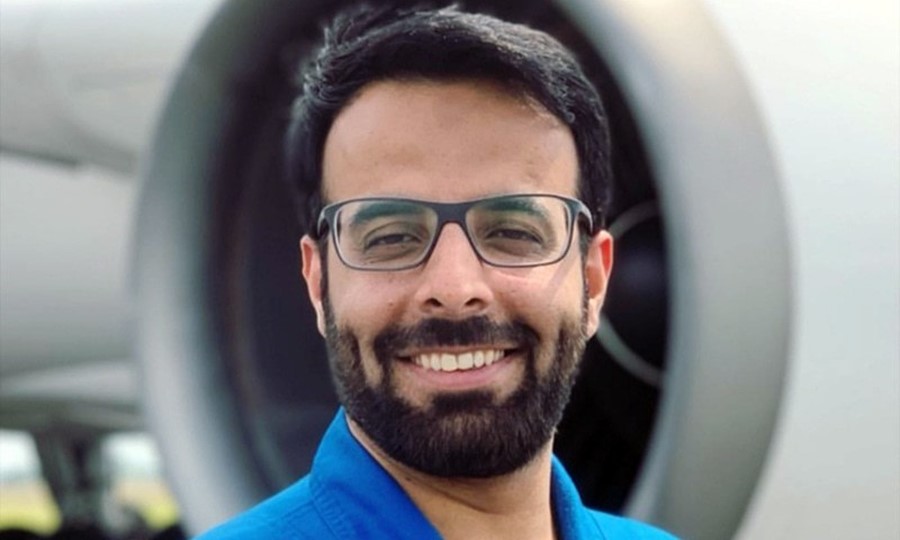Spotlight: Tweaking graphene’s properties to tackle societal challenges
From space and energy to sustainability and healthcare, Graphene Flagship researcher Yarjan Abdul Samad is keen on solving today’s problems with innovative materials
Yarjan Abdul Samad joined the Graphene Flagship in September 2016 and currently has fingers in a lot of pies! He is part of several work packages and spearhead projects within the Graphene Flagship: Flexible Electronics, Composites, Functional Foams and Coatings, Enabling Materials, Photonics and Optoelectronics, Energy Generation, Energy Storage, G+BOARD and GICE.
He is a Senior Research Associate at Graphene Flagship Partner the Cambridge Graphene Centre and a Teaching Fellow at the EPSRC Centre for Doctoral Training in Graphene Technology. Moreover, Samad was recently honoured as a Leader under 40 by the Foreign Ministry of Pakistan, his country of origin.
When did you start to work with graphene and why?
I started working on graphene and layered materials in 2012 during my PhD at the Khalifa University of Science & Technology in the UAE. I was interested in developing materials for aerospace applications and I was among the first in UAE to work with and produce graphene. I started a project on graphene-coated textiles, also known as graphene e-textiles. This study was benchmarked by scientists from across the globe and has since been a topic of interest within the graphene community.
What is your current goal?
My objective is to produce and modify graphene and layered materials via industrially scalable methods. We use production techniques, such as liquid-phase exfoliation, and tweak layered materials’ properties to suit the required functionalities for each desired application. We also employ manufacturing techniques to get as close to a product as possible.
Why do you feel your research is important, and what benefits could it bring to society?
In my research, I try to solve challenges related to space, energy, environment and healthcare with graphene and other layered materials. My objective is to use new materials to solve problems that would otherwise be impossible to solve with traditional materials. For example, we are looking into using graphene and layered materials for cooling and healing wounds in space, and for gas sensors and air remediation tools, high-capacity batteries and neural interface electrodes. Scientific knowledge gained through my research could benefit both the environment and the economy.
What are the biggest milestones in your career – or your proudest moments?
I am part of a Graphene Flagship team that tested graphene-coated loop heat pipes in zero gravity and on board the sounding rocket, MAterials Science Experiment Rocket (MASER) 14, in collaboration with the European Space Agency (ESA). These experiments showed us the potential of using graphene and layered materials to address some pressing challenges in space, such as radiation protection and wound healing, amongst others.
Why do you feel that diversity in science and technology is important for the Graphene Flagship's progress? What are you, your group or your institution doing to further this cause?
Innovation in the Graphene Flagship does not arise on its own, rather it is brought forth by the hard work and enterprise of scientists coming from different racial, lingual and cultural backgrounds. We work in teams to solve some of the most critical societal issues with the help of graphene and layered materials. The Cambridge Graphene Centre is in continuous pursuit of academic excellence through equality of opportunity and a proactive and inclusive approach to equality. This, in my view, supports and encourages all under-represented groups, promotes an inclusive culture and values diversity. We also actively take part in all the Graphene Flagship’s efforts towards diversity and inclusivity, such as the Diversity in Graphene initiative.
What are your plans for the future?
I come from Baluchistan, Pakistan, and I have spent many years in the UAE. I wish to strengthen research and education links between both nations because it is time that the world of science benefits from the skills and thirst for knowledge that people in Pakistan's Baluchistan region possess.
References
Yapici, Murat Kaya, et al. "Graphene-clad textile electrodes for electrocardiogram monitoring." Sensors and Actuators B: Chemical 221 (2015): 1469-1474.
Samad, Yarjan Abdul, et al. "Non-destroyable graphene cladding on a range of textile and other fibers and fiber mats." Rsc Advances 4.33 (2014): 16935-16938.
Samad, Yarjan Abdul, et al. "From sewing thread to sensor: Nylon® fiber strain and pressure sensors." Sensors and Actuators B: Chemical 240 (2017): 1083-1090.

Yarjan Abdul Samad, Senior Research Associate at Graphene Flagship Partner the Cambridge Graphene Centre.

Yarjan Abdul Samad was listed by the Foreign Ministry of Pakistan among the 25 under 40 leaders.




 Discover what does it take to bring graphene into space!
Discover what does it take to bring graphene into space!